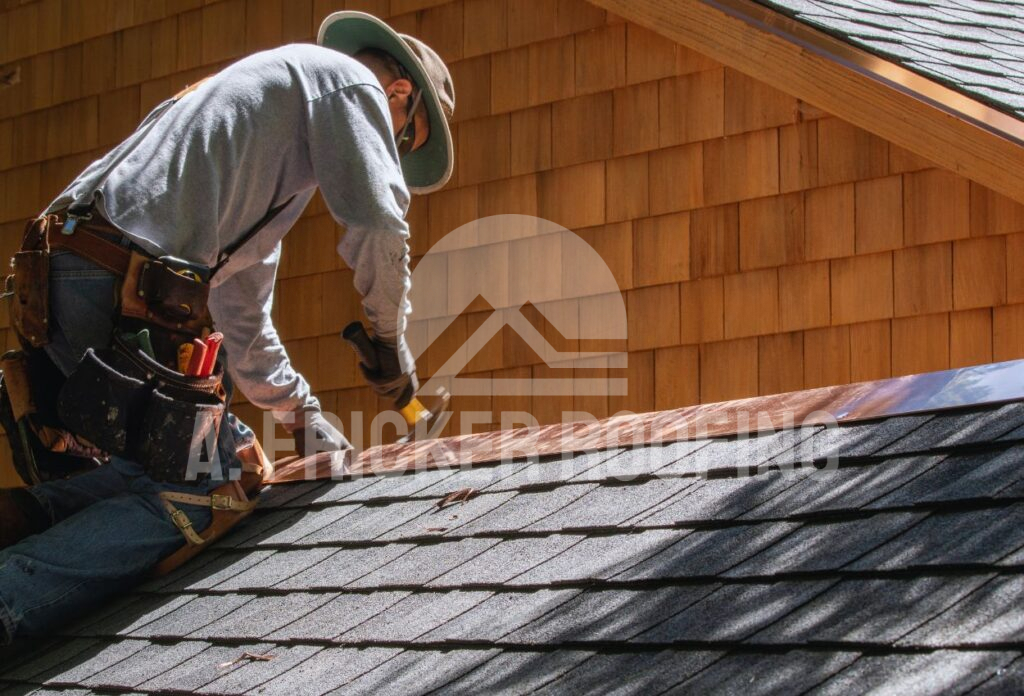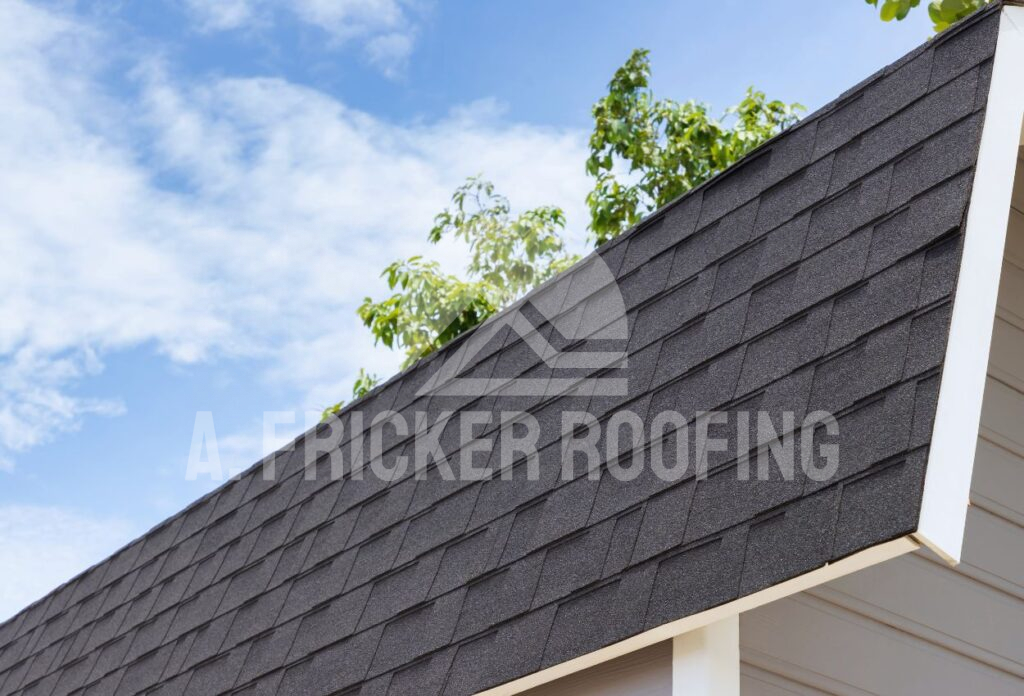If you’re a homeowner with a shingle roof, you might be all too familiar with the occasional (or maybe not so occasional) patches of moss or algae creeping across your roof. Not only are they an eyesore, but they can also lead to some pretty unpleasant roofing issues down the line.
This is an even bigger issue if you live in areas where the humidity levels are higher than average and there is more moisture.
So how do you protect your roof from the threat of shingle damage? The answer: copper roof strips. There’s a recent tactic that’s getting some attention. But do these strips live up to the hype and can they actually help protect your shingles from damage?
What Are Copper Roof Strips And How Do They Work?

Copper roof strips are just what they sound like, thin strips of copper that are installed along the roof, usually just below the ridge or along key areas where moss and algae tend to thrive. They work because of a chemical reaction that takes place when it rains.
When rainwater washes over these copper strips, it causes a small amount of copper ions to be released and flow down the roof. These ions are toxic to many forms of organic growth, like moss, algae, and lichen. As the rainwater spreads these copper ions across your shingles, it effectively creates an environment that discourages growth. Over time, this can prevent new moss or algae from taking hold and slow down the buildup of organic material that might damage your shingles.
The Appeal of Copper Roof Strips for Homeowners with Shingle Roofs
Shingle roofs, as durable as they are, are especially prone to moss and algae growth because of their texture and surface materials. Asphalt and wood shingles can create a cozy environment for moss and algae, especially if there’s regular moisture (think rainy seasons, humid climates, or shaded areas).
Most homeowners believe that moss growth is just a surface-level issue that reduces the curb appeal of their home. But there is much more to that. Once moss or algae take root, they don’t just stop at looking bad, they can actually lead to structural issues:
- Moisture Retention: Moss and algae hold onto moisture, which can lead to faster deterioration of shingles. More so if you have traditional shingles (3-tab) installed.
- Damage to the Protective Granules: The surface granules on asphalt shingles are there to protect them from the sun and extend their lifespan. When moss or algae settle in, they can gradually wear away at these granules, exposing the shingle material to UV rays and speeding up deterioration.
- Lifted or Curled Shingles: Moss can grow beneath shingles, lifting or curling them and making it easier for water to seep in.
All of these issues can shorten the life of your roof and lead to more repairs down the road. So, for homeowners who are dealing with moss and algae growth on a regular basis, copper roof strips seem like a promising solution.
Benefits Of Installing Copper Strips Along The Roof’s Ridge
Here are some of the benefits of installing a copper strip on your roof:
- Prevents Moss and Algae Growth: Copper ions naturally deter moss, algae, and lichen from taking root on your shingles, keeping your roof looking clean and fresh.
- Extends The Roof’s Lifespan: By preventing organic growth that can trap moisture, copper strips help protect the integrity of your shingles, which can reduce the frequency of repairs and extend your roof’s lifespan.
- Low Maintenance: Unlike roof coatings that may require reapplication, copper roof strips are a set it and forget it solution. Once installed, they work continuously without needing regular upkeep.
Also Read: Is Copper Flashing Worth It?
What To Consider Before Installing Copper Roof Strips:
Copper roof strips can definitely be effective, but there are a few things to keep in mind before you install them on your roof. They’re not a one-size-fits-all solution, and the results can vary based on factors like roof slope, local climate, and even the exact placement of the strips. Here’s a closer look at what to expect:
Copper Strips Are Preventative
Copper roof strips are primarily preventative. If you already have moss or algae growing on your roof, the strips won’t magically remove it. You’ll likely need to have the roof cleaned first before installing the strips to get the most benefit. But once installed, they do a great job of stopping new growth from taking over.
More Effective in Rainy or Humid Climates:
The effectiveness of the copper strips relies on rain to activate the copper ions. If you live in an area with frequent rain or high humidity, the copper ions will be distributed more frequently, making the strips more effective. In drier climates, the strips may still work, but they’ll be slower in releasing the ions, so you might see less dramatic results.
Better Suited for Certain Roof Angles and Designs:
The copper ions have to flow down the roof with the rainwater, so roofs with steep angles or large slopes benefit more than flat or gently sloping roofs.
Copper vs. Zinc Strips: Which Is Better For Your Roof?
If you have been doing some research, you might have come across zinc as an alternative to copper roof strips to prevent moss. While both copper and zinc strips are effective for keeping organic growth in check, they have some key differences.
Copper strips release copper ions that are highly effective at preventing growth, especially in areas with heavy moss, and they have a longer lifespan, though they come with a higher upfront cost. Copper roof strips also offer UV resistance, which is an added benefit.
On the other hand, zinc roof strips are generally more budget-friendly and still offer good protection, though they may need to be replaced sooner in certain climates.
What Are The Alternatives To Installing Copper Strips On A Roof?
If you’re still on the fence about installing copper stips on your roof, there are a few other methods to keep your shingle roof in top shape:
Regular Roof Cleanings: Annual or bi-annual professional roof cleanings can effectively remove moss and algae. Moss and mildew are easier to get rid of when they are caught early. Even if you do not have black streaks or algae on your roof, regular cleaning and maintenance are still recommended as they can extend the life of your roof.
Also Read: Guide To Shingle Roof Maintenance For Residential Roofs
Algae-Resistant Shingles: If you are looking to install new shingles, make sure that you get algae-resistant options. Most shingle manufacturers offer algae-resistant shingles that are treated with copper or zinc granules. These shingles provide similar benefits without needing copper strips.

Roof Coatings: Some homeowners opt for coatings that can help resist algae and moss. These are less common for residential roofs but might be an option for certain shingle types.
Protect Your Roof Today With The Experts At A. Fricker Roofing and Waterproofing
Copper roof strips are an innovative solution for homeowners tired of dealing with moss and algae on their shingle roofs. They’re easy to install, low maintenance, and can help keep your roof looking great and last for years to come.
If you’re interested in installing copper roof strips, or have more questions about how they could benefit your specific roof, feel free to reach out to us! At A. Fricker Roofing and Waterproofing, we have years of experience installing brand-new algae-resistant asphalt shingles. We use shingles manufactured by industry leaders such as CertainTeed and GAF.
Contact us today at (918) 402-7167.

